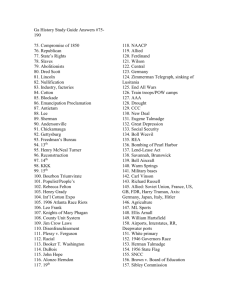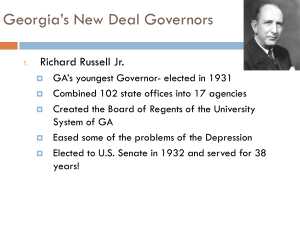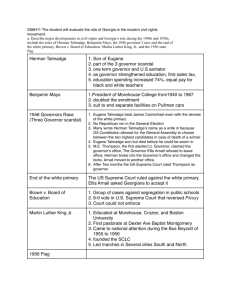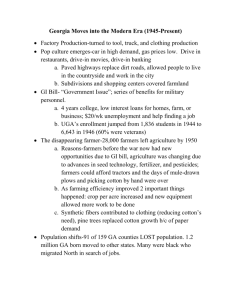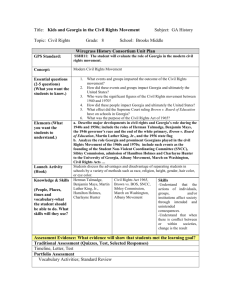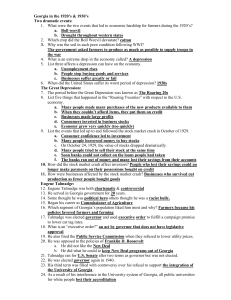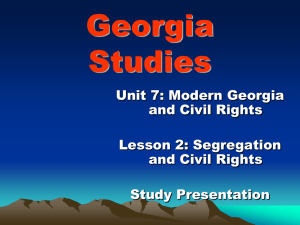Powerpoint SS8H11 - Polk School District
advertisement
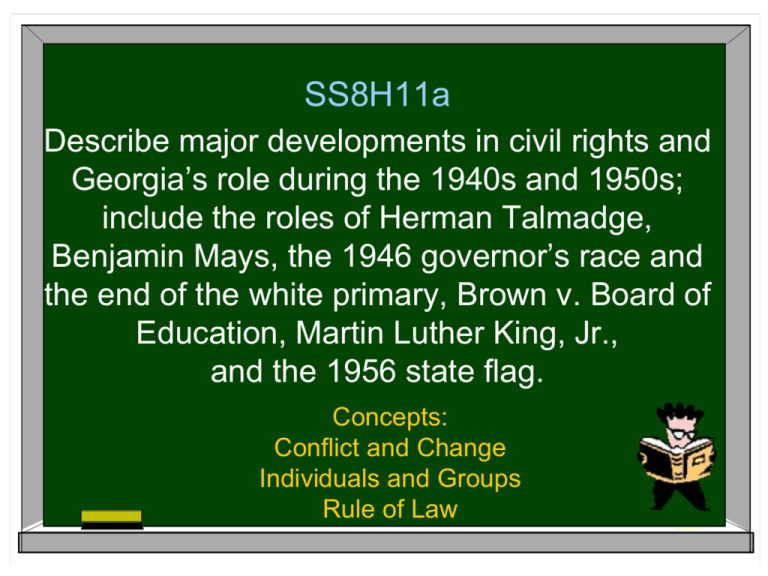
SS8H11a Describe major developments in civil rights and Georgia’s role during the 1940s and 1950s; include the roles of Herman Talmadge, Benjamin Mays, the 1946 governor’s race and the end of the white primary, Brown v. Board of Education, Martin Luther King, Jr., and the 1956 state flag. Concepts: Conflict and Change Individuals and Groups Rule of Law WHAT ROLE DID THE FOLLOWING PEOPLE AND EVENTS PLAY IN THE CIVIL RIGHTS MOVEMENT OF THE 1940s and 1950s? 1940s 1950s 1946 GOVERNOR’S RACE / END OF WHITE PRIMARY BROWN v. BOARD OF EDUCATION HERMAN TALMADGE DR. MARTIN LUTHER KING, Jr. BENJAMIN MAYS 1956 STATE FLAG Georgia's Three Governors Controversy In 1947, one of the most bizarre incidents took place in the history of U.S. state politics. Eugene Talmadge had been elected governor of Georgia for the fourth time in November 1946. The problem arose when "Ole' Gene" died of cirrhosis of the liver on December 21,1946 before he had been inaugurated governor.The controversy that followed quickly evolved into a constitutional crisis. This was the first time blacks were allowed to vote in the primary since Reconstruction. QuickTime™ and a TIFF (Uncompressed) decompressor are needed to see this picture. Who would become the governor of Georgia? QuickTi me™ and a TIFF ( Uncompressed) decompressor are needed to see thi s pi ctur e. Would it be Herman Talmadge? Knowing that Eugene Talmadge was not well going into the November general election, some of Talmadge's followers undertook a write-in campaign his son, Herman Talmadge. The reason for the write-in campaign was due to a provision which stated that the Georgia General Assembly would elect a governor from the next two candidates, "then in life" if the winner of the general election died before taking office. Since no Republican candidate was present, the Talmadgites reasoned that young "Hummon" would become governor should Eugene die. QuickTi me™ and a TIFF ( Uncompressed) decompressor are needed to see thi s pi ctur e. Would it be Ellis Arnall? The outgoing governor, Ellis Arnall, announced that he would not leave the office until it was clear who the new governor was. Arnall's actions galvanized Talmadge's supporters, who bitterly hated his anti-Talmadge policies. The legislature's election of Talmadge provoked a confrontation between the Talmadge and Arnall camps. Talmadge asked Arnall to honor the General Assembly's election. Arnall maintained that the legislature had no right to elect a governor and refused to step aside. Talmadge then ordered state troopers to remove Arnall from the capitol and see that he returned home safely. On January 15, the day of the legislative election, both Herman Talmadge and Ellis Arnall claimed to be governor of Georgia and shared the same offices in the capitol. By the next day Talmadge had seized control of the governor's office and had the locks on the doors changed. Arnall continued to maintain his position as governor and even set up a governor's office in exile in an information kiosk in the capitol. Ultimately, Arnall relinquished his claim as governor and supported Thompson. Would it be Melvin Thompson? QuickTi me™ and a TIFF ( Uncompressed) decompressor are needed to see thi s pi ctur e. In the wake of Talmadge's death, his supporters proposed a plan that allowed the Georgia legislature to elect a governor in January 1947. When the General Assembly elected Talmadge's son as governor, the newly elected lieutenant governor, Melvin Thompson, claimed the office of governor since as the lieutenant governor he would replace the governor in case of death. In March 1947 the Georgia Supreme Court ruled that Melvin Thompson was the rightful governor because he was lieutenant governor–elect when Eugene Talmadge died. In a five-to-two decision the justices ruled that Thompson would be the acting governor until a special election could be held to decide the remainder of the original term. Turn-and-talk with a partner and complete the 3 governors controversy section of your graphic organizer. SOCIAL CHANGE IN AMERICA WHILE THE REST OF AMERICA WAS EMBRACING SOCIAL EQUALITY AND FAIRNESS BETWEEN WHITE AND BLACK AMERICANS, HERMAN TALMADGE TRIED TO MAINTAIN THE “JIM CROW” LAWS OF SEGREGATION. IF HERMAN TALMADGE HAD HIS WAY - YOU WOULDN’T SEE THIS ON TELEVISION Herman Talmadge •Seved in Navy during WWII •Law degree from UGA •Followed father Eugene into politics •Served as governor in late 40s early 50s •Part of 3 governors controversy •Brought first sales tax to GA to help fund public schools •Attracted new businesses to our state •Served as US Senator 1956-1981 •Sponsored bill that created Food Stamps to not only help poor but to provide a market for farmers as well •Price controls and other support for Ag. •Ag, Finance, and Watergate Committees •National figure as GA Senator He can be considered generally progressive in the context of Georgia politics at that time. However, like most southern governors of that era, Talmadge was a staunch segregationist who resisted all attempts to integrate the public school system. QuickTime™ and a TIFF (Uncompressed) decompressor are needed to see this picture. Turn-and-talk with a partner and complete the Herman Talmadge section of your graphic organizer. Benjamin Mays •African American minister.educator, scholar, social activist •Longtime president of Morehouse College •Significant mentor to MLK, Jr. QuickTi me™ and a TIFF ( Uncompressed) decompressor are needed to see thi s pi ctur e. •One of the most articulate and outspoken critics of segregation before the rise of Civil Rights Mays's unwavering emphasis on two ideas in particular the dignity of all human beings and the incompatibility of American democratic ideals with American social practices became vital strains in the language of King and the civil rights movement. Turn-and-talk with a partner and complete the Benjamin Mays section of your graphic organizer. BROWN v. BOARD OF EDUCATION SUPREME COURT CASE IF BROWN v. BOARD OF EDUCATION ENDED SEGREGATION IN PUBLIC SCHOOLS IN 1954, THEN HOW COME IT TOOK SOUTHERN STATES OVER A DECADE TO FINALLY INTEGRATE? THIS PICTURE IS FROM A COURT HOUSE IN GEORGIA. THE SUPREME COURT IN PLESSY V. FERGUSON RULED THAT SEGREGATION WAS LEGAL AS LONG AS FACILITIES WERE EQUAL. DOES THAT LOOK EQUAL? HOW IRONIC THAT THE WATER FOUNTAINS IN THIS PHOTO ARE IN A COURT HOUSE, OF ALL PLACES. Turn-and-talk with a partner and complete the Brown v. Board of Education section of your graphic organizer. Dr. MARTIN LUTHER KING, Jr. Turn-and-talk with a partner and complete the Martin Luther King, Jr. section of your graphic organizer. QuickTime™ and a TIFF (Uncompressed) decompressor are needed to see this picture. State Flag, 1956-2001 Georgia's General Assembly ratified the addition of the Confederate Battle Flag to the state flag in 1956 as a backlash to the Brown v. Board of Educationハdecisions, which federally imposed integration of public schools. WHAT ROLE DID THE FOLLOWING PEOPLE AND EVENTS PLAY IN THE CIVIL RIGHTS MOVEMENT OF THE 1940S and 1950s? 1940s 1946 GOVERNOR’S RACE / END OF WHITE PRIMARY • 1st time blacks allowed to vote in primary election since Reconstruction. • Eugene Talmadge lost the popular vote but won the election b/c of the county unit system (rural support), but died before taking office, which created the “Three Governors Controversy”. HERMAN TALMADGE 1950s BROWN v. BOARD OF EDUCATION • Overturned the Plessy v. Ferguson court case that allowed “Jim Crow “ segregation laws • Segregation of public schools became illegal and unconstitutional because in reality separate facilities were not equal. DR. MARTIN LUTHER KING, Jr. Became Governor of Georgia after the Three Governor’s Controversy. • Like his father Eugene, Herman was a segregationist and supporter of white supremacy. • Civil Rights leader from Atlanta • Led the Montgomery bus boycott after Rosa Parks was arrested • Led non-violent protest marches and speeches to gain racial equality in America BENJAMIN MAYS 1956 STATE FLAG • Minister, educator, civil rights activist, and president of Morehouse College • Was a mentor to his student Martin Luther King • Believed in the dignity of all human beings • Believed that there was a difference between American democracy and actual social practices. • Flag was changed to include the Confederate battle emblem as a sign of protesting the integration of blacks into all white public schools • The flag would be changed in 2001 • SS8H11b Analyze the role Georgia and prominent Georgians played in the Civil Rights Movement of the 1960s and 1970s; include such events as the founding of the Student Non-Violent Coordinating Committee (SNCC), Sibley Commission, admission of Hamilton Holmes and Charlayne Hunter to the University of Georgia, Albany Movement, March on Washington, Civil Rights Act, the election of Maynard Jackson as mayor of Atlanta, and the role of Lester Maddox. Concepts: Conflict and Change Individuals and Groups Rule of Law IF BROWN v. BOARD OF EDUCATION ENDED SEGREGATION IN PUBLIC SCHOOLS IN 1954, THEN HOW COME IT TOOK SOUTHERN STATES OVER A DECADE TO FINALLY INTEGRATE? 1954 BROWN V. BOARD OF EDUCATION Supreme Court rules 9-0 that segregation in public schools is illegal unconstitutional 1956 GEORGIA STATE FLAG Georgia changed the state flag to protest Brown v. BOE Georgia was against integration 1960 1961 SIBLEY DESEGREGATING UNIVERSITY OF GEORGIA COMMISSION Georgia had to decide whether to close schools or integrate. The state asked citizens. Hamilton Holmes and Charlayne Hunter became the 1st AfricanAmerican students to attend UGA. 1964 CIVIL RIGHTS ACT Segregation of public facilities were outlawed. This was the end of the Jim Crow era. SS8H11b Analyze the role Georgia and prominent Georgians played in the Civil Rights Movement of the 1960s and 1970s; include such events as the founding of the Student Non-Violent Coordinating Committee (SNCC), Sibley Commission, admission of Hamilton Holmes and Charlayne Hunter to the University of Georgia, Albany Movement, March on Washington, Civil Rights Act, the election of Maynard Jackson as mayor of Atlanta, and the role of Lester Maddox. Concepts: Conflict and Change Individuals and Groups Rule of Law SNCC • STUDENT NON-VIOLENT COORDINATING COMMITTEE • Young blacks and whites organized sitins, marches, freedom rides, and voter registration to end segregation in the South. 1961 ALBANY MOVEMENT 1963 MARCH ON • Movement to desegregate the city of Albany • SNCC, Martin Luther King, Jr., and the NAACP used nonviolent protests, marches, and boycotts. Hundreds were arrested, including Martin Luther King. • Large rally for jobs and freedom • 300,000 Americans attended and listened to Martin Luther King, Jr. give his famous “I Have A Dream” speech. • The march helped pass the Civil Rights Act of 1964 WASHINGTON SNCC • STUDENT NON-VIOLENT COORDINATING COMMITTEE • Young blacks and whites organized sitins, marches, freedom rides, and voter registration to end segregation in the South. 1961 ALBANY MOVEMENT 1963 MARCH ON • Movement to desegregate the city of Albany • SNCC, Martin Luther King, Jr., and the NAACP used nonviolent protests, marches, and boycotts. Hundreds were arrested, including Martin Luther King. • Large rally for jobs and freedom • 300,000 Americans attended and listened to Martin Luther King, Jr. give his famous “I Have A Dream” speech. • The march helped pass the Civil Rights Act of 1964 WASHINGTON IF BROWN v. BOARD OF EDUCATION ENDED SEGREGATION IN PUBLIC SCHOOLS IN 1954, THEN HOW COME IT TOOK SOUTHERN STATES OVER A DECADE TO FINALLY INTEGRATE? 1954 BROWN V. BOARD OF EDUCATION Supreme Court rules 9-0 that segregation in public schools is illegal unconstitutional 1956 GEORGIA STATE FLAG Georgia changed the state flag to protest Brown v. BOE Georgia was against integration 1960 1961 SIBLEY DESEGREGATING UNIVERSITY OF GEORGIA COMMISSION Georgia had to decide whether to close schools or integrate. The state asked citizens. Hamilton Holmes and Charlayne Hunter became the 1st AfricanAmerican students to attend UGA. 1964 CIVIL RIGHTS ACT Segregation of public facilities were outlawed. This was the end of the Jim Crow era. SS8H11b Analyze the role Georgia and prominent Georgians played in the Civil Rights Movement of the 1960s and 1970s; include such events as the founding of the Student Non-Violent Coordinating Committee (SNCC), Sibley Commission, admission of Hamilton Holmes and Charlayne Hunter to the University of Georgia, Albany Movement, March on Washington, Civil Rights Act, the election of Maynard Jackson as mayor of Atlanta, and the role of Lester Maddox. Concepts: Conflict and Change Individuals and Groups Rule of Law SS8H11c Discuss the impact of Andrew Young on Georgia. Concept: Individuals and Groups MAYNARD JACKSON • First African-American mayor of Atlanta in 1974 • Expanded Hartsfield Airport, now called Hartsfield-Jackson • Helped bring the 1996 Olympics to Atlanta LESTER MADDOX • Segregationist - Became Governor of Georgia in 1967 • Became more compassionate by appointing more blacks to positions in government than any other governor before him and integrated the Georgia State Patrol. ANDREW YOUNG • Leader in Civil Rights movement with Martin Luther King • 1st black person elected to US House of Representatives from Georgia since Reconstruction • UN Ambassador and mayor of Atlanta who also helped bring the Olympics to Atlanta MAYNARD JACKSON LESTER MADDOX ANDREW YOUNG
